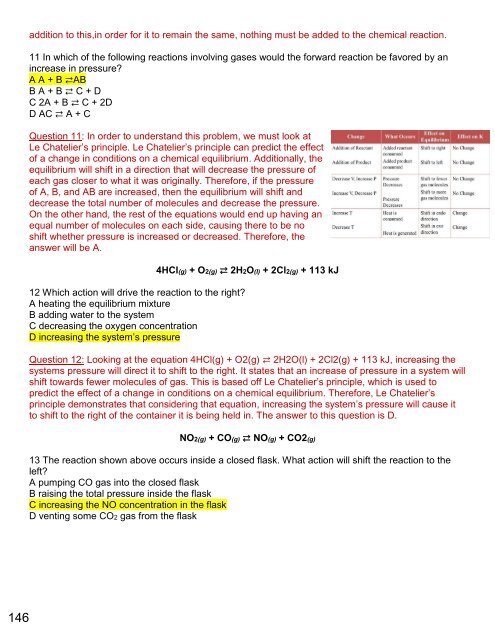You also want an ePaper? Increase the reach of your titles
YUMPU automatically turns print PDFs into web optimized ePapers that Google loves.
addition to this,in order for it to remain the same, nothing must be added to the chemical reaction.<br />
11 In which of the following reactions involving gases would the forward reaction be favored by an<br />
increase in pressure?<br />
A A + B ⇄AB<br />
B A + B ⇄ C + D<br />
C 2A + B ⇄ C + 2D<br />
D AC ⇄ A + C<br />
Question 11: In order to understand this problem, we must look at<br />
Le Chatelier’s principle. Le Chatelier’s principle can predict the effect<br />
of a change in conditions on a chemical equilibrium. Additionally, the<br />
equilibrium will shift in a direction that will decrease the pressure of<br />
each gas closer to what it was originally. Therefore, if the pressure<br />
of A, B, and AB are increased, then the equilibrium will shift and<br />
decrease the total number of molecules and decrease the pressure.<br />
On the other hand, the rest of the equations would end up having an<br />
equal number of molecules on each side, causing there to be no<br />
shift whether pressure is increased or decreased. Therefore, the<br />
answer will be A.<br />
12 Which action will drive the reaction to the right?<br />
A heating the equilibrium mixture<br />
B adding water to the system<br />
C decreasing the oxygen concentration<br />
D increasing the system’s pressure<br />
4HCl(g) + O2(g) ⇄ 2H2O(l) + 2Cl2(g) + 113 kJ<br />
Question 12: Looking at the equation 4HCl(g) + O2(g) ⇄ 2H2O(l) + 2Cl2(g) + 113 kJ, increasing the<br />
systems pressure will direct it to shift to the right. It states that an increase of pressure in a system will<br />
shift towards fewer molecules of gas. This is based off Le Chatelier’s principle, which is used to<br />
predict the effect of a change in conditions on a chemical equilibrium. Therefore, Le Chatelier’s<br />
principle demonstrates that considering that equation, increasing the system’s pressure will cause it<br />
to shift to the right of the container it is being held in. The answer to this question is D.<br />
NO2(g) + CO(g) ⇄ NO(g) + CO2(g)<br />
13 The reaction shown above occurs inside a closed flask. What action will shift the reaction to the<br />
left?<br />
A pumping CO gas into the closed flask<br />
B raising the total pressure inside the flask<br />
C increasing the NO concentration in the flask<br />
D venting some CO2 gas from the flask<br />
146




